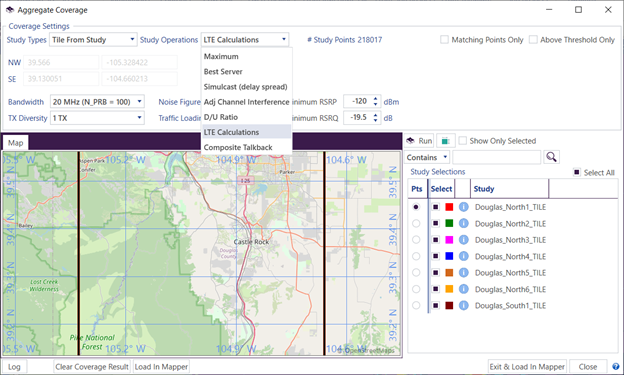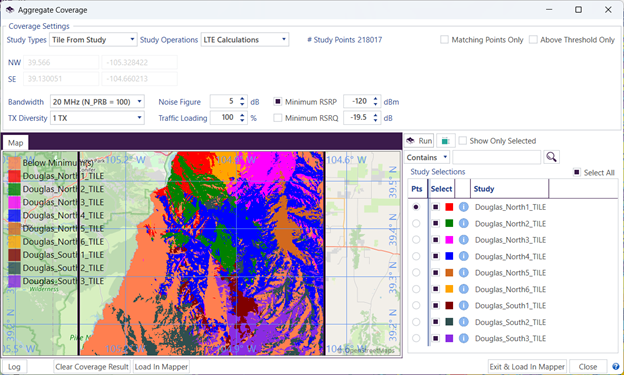With the release of TAP 7.6.9, the LTE Calculations operation was added to the Aggregate Coverage module. Users with maintenance expiration dates later than December 1, 2023 have access to this study operation, which may be found under the Study Operations dropdown, as shown in Figure 1. The LTE Calculations aggregation operation calculates the Reference Signal Received Power (RSRP, in dBm) and Reference Signal Received Quality (RSRQ, in dB) from the TalkOut received power of multiple sites.

The LTE Calculations operation has six input parameters: (1) Bandwidth, which sets the number of physical Resource blocks (NPRB); (2) TX Diversity, set to one or two transmitters active; (3) Noise Figure, in dB; (4) Traffic Loading, from 0%, with reference signals only, to fully loaded at 100% (linear interpolation between the two extremes); (5) Minimum RSRP, in dBm; and (6) Minimum RSRQ, in dB. There are checkboxes for the Minimum RSRP and Minimum RSRQ that allow the user to select whether they are used as thresholds. For study points that fall below the selected minimum(s), they are assigned in the output COVSOURCE field as “Below Minimum(s).”
The following definitions (shown in italics) for RSRP, RSRQ, and Received Signal Strength Indicator (RSSI) are from [1]:
Reference signal received power (RSRP), is defined as the linear average over the power contributions (in [W]) of the resource elements that carry cell-specific reference signals within the considered measurement frequency bandwidth.
Reference Signal Received Quality (RSRQ) is defined as the ratio N×RSRP/(E-UTRA carrier RSSI), where N is the number of RBs of the E-UTRA carrier RSSI measurement bandwidth. The measurements in the numerator and denominator shall be made over the same set of resource blocks.
E-UTRA Carrier Received Signal Strength Indicator (RSSI), comprises the linear average of the total received power (in [W]) observed only in certain OFDM symbols of measurement subframes, in the measurement bandwidth, over N number of resource blocks by the UE from all sources, including co-channel serving and non-serving cells, adjacent channel interference, thermal noise etc. (See [1] for more detail.)
For LTE, in the temporal dimension, a radio frame is 10 ms in duration. Each radio frame consists of 20 time slots (numbered 0 to 19), each 0.5 ms in duration. Each time slot consists of seven orthogonal frequency division multiplexing (OFDM) symbols (numbered 0 to 6). In the frequency domain, a physical resource block (PRB) consists of twelve 15 kHz subcarriers (numbered 0 to 11). A single resource element (RE) corresponds to a unique OFDM symbol and subcarrier pair. Reference signals are transmitted on subcarriers 1 and 7 for symbol 0; and on subcarriers 4 and 10 for symbol 4. If a diversity transmitter is in use, diversity reference signals are transmitted on subcarriers 4 and 10 for symbol 0; and on subcarriers 1 and 7 for symbol 4.
The RSRP is effectively the received power of one RE, averaged over all reference signal symbols. In the LTE Calculations aggregation operation, at a given study point, RSRP is calculated for all selected studies. Under the fully loaded condition, the RSRP, in dB, is the received power (i.e., Power_dBm, for the current study), reduced by 10*log10(12*NPRB); for a 20 MHZ bandwidth, NPRB = 100, and the adjustment is then -30.79 dB. The study yielding the maximum RSRP is recorded in the output COVSOURCE field; its RSRP is recorded in the output RSRP_dBm field.
The RSSI is effectively the linear sum of the received power from all selected studies, both serving and non-serving, and noise (calculated using the user-selected Noise Figure and a Noise Temperature of 290 K). TAP does not do a check on the operating channels of the selected studies; the user should select only co-channel studies in the aggregation operation. The RSRQ calculation effectively takes the ratio of NPRB*RSRP/RSSI. The study yielding the maximum RSRQ will be the same as the study with maximum RSRP; its RSRQ is recorded in the output RSRQ_dB field.
After running the aggregate study and loading the result into Mapper, the RSRP_dBm and RSRQ_dB output fields can be selected under the Value Range Style tab in the study’s layer settings, Style tab. The LTE Calculations setup window and example results output are shown below.

